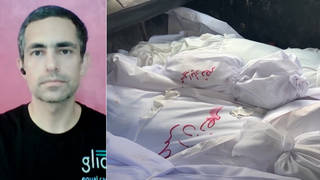
Guests
- Trevor Aaronsoncontributing writer at The Intercept and executive director of the nonprofit Florida Center for Investigative Reporting. He is the author of The Terror Factory: Inside the FBI’s Manufactured War on Terrorism. His most recent article for The Intercept is “The Sting: How the FBI Created a Terrorist.”
- Avni Osmakacbrother of Sami Osmakac.
Links
- PART TWO: "How the FBI Created a Terrorist" By Entrapping Mentally Ill Man in Florida
- Read: "The Sting: How the FBI Created a Terrorist" by Trevor Aaronson (The Intercept)
- Book: "The Terror Factory: Inside the FBI's Manufactured War on Terrorism" by Trevor Aaronson
- Follow Trevor Aaronson on Twitter
- Florida Center for Investigative Reporting
“How the FBI Created a Terrorist.” That’s the subtitle of a new exposé in The Intercept by Trevor Aaronson, a journalist who investigates the FBI’s use of informants in sting operations. The article tells the story of Sami Osmakac, a mentally disturbed, financially unstable young man who was targeted by an elaborately orchestrated FBI sting in early 2012. The operation involved a paid informant who hired Osmakac for a job, when he was too broke to afford inert government weapons. The FBI provided the weapons seen in a so-called martyrdom video Osmakac filmed before he planned to deliver what he believed was a car bomb to a bar in Tampa, Florida. His family believes Osmakac never would have initiated such a plot without the FBI. And transcripts of conversations obtained by Aaronson show FBI agents appeared to agree, describing him as a “retarded fool” whose terrorist ambitions were a “pipe-dream scenario.” The transcripts show how the agents worked to get $500 to Osmakac so he could make a down payment on the weapons — something government prosecutors wanted to prove their case. In November 2014, Osmakac was sentenced to 40 years in federal prison, despite a court-appointed psychologist diagnosing him with schizoaffective disorder. We are joined by Avni Osmakac, the older brother of Sami Osmakac, and Trevor Aaronson, contributing writer at The Intercept and executive director of the nonprofit Florida Center for Investigative Reporting.
Transcript
AMY GOODMAN: This is Democracy Now!, democracynow.org, The War and Peace Report. I’m Amy Goodman, as we turn right now to our last segment. “How the FBI Created a Terrorist.” That’s the subtitle of a new exposé in The Intercept by Trevor Aaronson, a journalist who investigates the FBI’s use of informants in sting operations. The article tells the story about Sami Osmakac, a mentally disturbed, financially unstable young man who is targeted by an elaborately orchestrated FBI sting in early 2012. The operation involved a paid informant who hired Osmakac for a job when he was too broke to afford inert government weapons. The FBI provided the weapons seen in a so-called martyrdom video Osmakac filmed before he planned to deliver what he believed was a car bomb to a bar in Tampa, Florida. His family believes he never would have initiated such a plot without the FBI, and transcripts of conversations obtained by Aaronson show FBI agents appeared to agree. The transcripts show how the agents worked to get $500 to him so he could make a down payment on the weapons—something government prosecutors wanted to prove their case. This is part of an exchange between Special Agent Richard Worms and Special Agent Jacob Collins.
SPECIAL AGENT RICHARD WORMS: This poor guy, he gets almost 500 bucks in his hand tomorrow, and he says, “You need me for another week?” That’s a thousand bucks. Why wouldn’t he show up?
SPECIAL AGENT JACOB COLLINS: Well, right, but you’re a hard-working, logical human being.
SPECIAL AGENT RICHARD WORMS: No, I’m trying to think, if I’m a retarded fool who is hard up for money, and I don’t have a pot to [expletive] in, another $500 looks pretty good.
AMY GOODMAN: That was part of a conversation between FBI Special Agents Richard Worms and Jacob Collins referring to Sami Osmakac as a, quote, “retarded fool” in the lead-up to his arrest. In November 2014, he was sentenced to 40 years in federal prison, despite a court-appointed psychologist diagnosing him with schizoaffective disorder.
Well, for more, we’re joined now by two guests. In Tampa, Florida, we’re joined by Avni Osmakac, the older brother of Sami. And we’re joined by Trevor Aaronson, a contributing writer at The Intercept and executive director of the nonprofit Florida Center for Investigative Reporting. Trevor is the author of The Terror Factory: Inside the FBI’s Manufactured War on Terrorism, his most recent piece in The Intercept called “The Sting: How the FBI Created a Terrorist.” He’s joining us from Vancouver, Canada, where he delivered a TED talk this week on Sami Osmakac. Democracy Now! invited a spokesperson from the FBI to join us on the show, but the agency declined.
We welcome you both to Democracy Now! Trevor, let’s begin with you. Lay out this story.
TREVOR AARONSON: What’s particularly interesting about this case is that this is a rare, if first ever, look at behind the scenes of a counterterrorism sting operation. And organizations like Human Rights Watch have often criticized these types of sting operations for targeting mentally ill, economically desperate people who, on their owns, would not have the means to commit this type of crime. And these transcripts, the sealed transcripts that we obtained that were the accidentally recorded conversations among FBI agents as they were working the sting, certainly suggest that the FBI seems to agree with groups like Human Rights Watch, that in the case of Sami Osmakac, at least, they didn’t think he was capable of committing significant violence. You know, as the transcripts you showed earlier demonstrated, they thought he was a “retarded fool.” They describe his plot as “wishy-washy” and a “pipe-dream scenario.”
And, you know, the transcripts also show that they went to enormous lengths to put money in Sami Osmakac’s hands, to basically funnel money through an informant, who would then give it to Sami Osmakac so that Sami Osmakac could then purchase weapons from an undercover agent, which was something that the federal government insisted—excuse me, federal prosecutors insisted they needed to show Osmakac’s capacity for this type of crime. But, obviously, he didn’t have that type of capacity. And so, what these transcripts show, which are transcripts that a federal judge and the FBI never wanted released, they show that they went to an enormous length to orchestrate—and that’s their word, “orchestrate”—a situation where Sami Osmakac would be given money to then purchase weapons, and so he could be, essentially, kind of created as a terrorist in this FBI sting operation.
AMY GOODMAN: Where does the Hollywood ending come in?
TREVOR AARONSON: So, as this sting was progressing, the FBI squad supervisor, Richard Worms, was talking to his agents about discussions he was having with federal prosecutors, and he described how federal prosecutors wanted a “Hollywood ending” to their sting operation. What’s particularly troublesome about that terminology, I think, is that it clearly shows that the FBI was not only controlling every aspect of the sting operation, but they were controlling it in such a way that they wanted a splashy ending, a Hollywood ending, as he says.
And they essentially got a Hollywood ending. They were able to get Sami Osmakac to record a so-called martyrdom video, in which he’s wearing a suicide vest and has an AK-47 leaned up against a closet door behind him—all of which were provided by the FBI. And at the very end, they get him to attempt to deliver a car bomb, which was of course provided by the FBI. And as he backs out of a hotel parking lot, the car bomb in his trunk, FBI agents rush in and arrest him. And they essentially got their Hollywood ending. What’s concerning, I think, is that, you know, this isn’t the only case where a Hollywood ending has occurred. You know, Sami Osmakac is one of more than 175 so-called terrorists since 9/11 who have been caught in these types of sting operations. And you could certainly make a strong argument that in each of these sting operations, the FBI has created a Hollywood ending like we saw in Osmakac’s case.
AMY GOODMAN: Why did they target him?
TREVOR AARONSON: It’s still unclear exactly why they targeted him. According to the FBI’s official story on this, Osmakac happened to go into a Middle Eastern market that was run by an informant, a man named Abdul Dabus. And Dabus claimed that Osmakac asked him if he had al-Qaeda flags. In turn, Dabus then called the FBI, and they launched a sting operation against him. And that was the beginning of the operation, according to the government.
Sami Osmakac denies that he ever asked anyone for an al-Qaeda flag. And certainly, there’s questions about how FISA evidence was used and whether the government may have used surveillance before the introduction of the informant. That is to say that before he met Dabus, the informant, did the government know or somehow want to target Sami Osmakac? And there are certainly suggestions along that line. I mean, it certainly is miraculous that Sami Osmakac would travel 45 minutes from his home and meet someone who just so happens to be an FBI informant and then target him.
But to make clear, the government, in the trial, never was able to provide any evidence that Sami Osmakac had any connections to international terrorists groups. There was nothing in the record to suggest that he was on the verge of an attack, he had connections to people who could help him with an attack. This was, at best, an idea, an idea that was manipulated by the government through an FBI informant and an undercover agent. And in the end, the capacity for that idea—all of the weapons, all of the money—was provided by the FBI in this very elaborately orchestrated sting operation.
AMY GOODMAN: I want to turn to Avni Osmakac, who’s joining us from Tampa. What do you want people to understand about your brother’s case?
AVNI OSMAKAC: Well, I just want to make clear that whatever the government is playing in the media and that everything that’s gone on has been orchestrated by the government. They want you to see this. Behind the scenes, there’s 128 agents working on this, informants and everything. All the YouTube videos and everything have been orchestrated by the government. The same day my brother was arrested, the next day, the guy that’s holding the camera and everything behind, they all disappeared. There’s been multiple informants. The next day, they disappeared, and nobody knew what was going on. During the trial, they were denying that Russell was an informant. But in the sentencing, one of the agents slipped and said they knew exactly where he was and they knew his location. And then our lawyer asked him, “So does that mean that he’s working for you?” And their response was, “That’s national security. We cannot discuss this with you guys.” So I know for a fact—I’ve been saying this since day one—this was an FBI sting, FBI entrapment, since day one it came to the media. And I just want people to wake up and see this is not the first time this happened. It just happened in Ohio again. It happened in New York a couple weeks ago with the three guys. This has been going on. And they’re targeting people that are going through their own challenges. And this needs to stop.
AMY GOODMAN: Avni, we’re going to have to leave it there, but we’re going to continue this discussion right after the show and post it at democracynow.org. Avni Osmakac and Trevor Aaronson, thanks for joining us.













Media Options